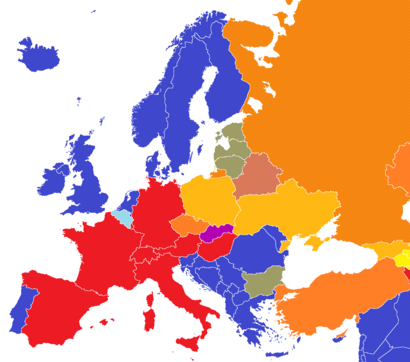Subtitles facts for kids
Subtitles are text that shows what people are saying or what sounds are happening in a movie, TV show, or other video. They can be a written version of the spoken words or a translation into a different language.
Sometimes, subtitles are called captions. Captions are special because they also describe other sounds, like music or sound effects. This makes them super helpful for people who are deaf or hard of hearing. Subtitles can also add extra information that isn't in the audio, like explaining a cultural detail. And sometimes, they're even used for jokes! For example, in the movie Annie Hall, subtitles show what characters are really thinking, even if they're saying something different out loud.
Contents
How Subtitles Are Made and Shown
Making, sharing, and showing subtitles involves a few steps.
Writing the Subtitles
First, someone needs to write the text for the subtitles. If there's lots of time, this can be done by hand. But for live TV, like news, people called stenographers might type them very quickly, or computers can use speech recognition to turn spoken words into text. Subtitles made by fans, not official companies, are called fansubs. No matter who writes them, they must include exact times for when each line of text should appear and disappear on screen.
Professional subtitlers use special computer programs. These programs let them see the video and decide exactly when each subtitle should pop up and go away. The final result is a subtitle file. This file contains the words and the timing information, often based on a special "timecode" for TV or video, or film length for movies.
Sharing Subtitles with Viewers
Next, subtitles need to get to you, the audience.
- Open subtitles are permanently added to the video itself. This means you can't turn them off.
- Closed subtitles are stored separately from the video. This is cool because it means you can choose different languages for subtitles without changing the video. There are many technical ways to store these subtitles.
Displaying Subtitles on Screen
Finally, subtitles need to be shown.
- Open subtitles are always there when you watch the video because they're part of it.
- Closed subtitles are optional. Your TV or media player adds them on top of the video if you choose to turn them on. Sometimes, in theaters, a separate screen above the main movie screen shows the subtitles. These are called surtitles.
Subtitles for Everyone
Subtitles are not just for people who need them for hearing. Many people use them for convenience!
Same-Language Captions
Captions in the same language as the audio were first made to help people who are deaf or hard of hearing.
What Are Closed Captions?
In America, "closed captions" are subtitles specifically for people who are deaf or hard of hearing. They don't just translate; they write down everything said and describe important sounds like (WIND HOWLING) or (DOOR CREAKING). This helps viewers understand the full experience. In the UK, these are often just called "subtitles for the deaf or hard-of-hearing" (SDH).
Live Captions
For live shows like news or sports, captions are created in "real time." This means a person or a computer types them as the words are spoken. There's usually a small delay of a few seconds. Sometimes, there might be typos because it's happening so fast!
Pre-prepared Captions
Some shows are ready a few hours before they air, but there isn't enough time for perfect, timed captions. These "pre-prepared" captions look good, but their timing might not be as exact.
Offline Captions
For shows that aren't live, like movies or recorded TV series, "offline captioning" is used. This allows for very detailed captions with special features like different styles, speaker names, and sound effects. It's a careful process that helps viewers really follow the story and feel the mood.
Subtitles for the Deaf or Hard-of-Hearing (SDH)
SDH is a term from the DVD world. It means regular subtitles in the original language, but with extra info about sounds and who is speaking. The main difference for you is how they look: SDH subtitles usually use a normal font, while older closed captions often appear as white text on a black bar. Many people find SDH easier to read because it doesn't block as much of the screen.
Sometimes, song lyrics aren't captioned because of copyright rules. This has led to some lawsuits, but courts have generally said that companies don't have to caption every single song lyric.
Why Hearing People Use Subtitles
Even if you can hear perfectly, subtitles are super useful! Many young people use them to understand dialogue better, especially if it's hard to hear, spoken quietly, or in an unfamiliar accent. A survey in the UK found that 80% of young adults (18-25) regularly use subtitles, while older groups use them much less.
Same Language Subtitling (SLS)
SLS means showing synchronized captions of words, like song lyrics, as a way to help people read. It's like a reading exercise where students watch a video with subtitles and then do a worksheet. When the text changes color with the audio, it's even more effective. Studies show that using subtitles can help kids improve their reading skills. Countries like China and India use SLS on national TV to boost literacy.
Subtitles in Asia
In some Asian TV shows, especially in Japan, subtitles are used artistically. Words might appear one by one, in different fonts, colors, and sizes to match the mood. This style has spread to countries like South Korea and Taiwan.
In Chinese-speaking areas, subtitles are very common because many different dialects are spoken, which can be hard to understand for people from other regions. But the written Chinese language is mostly the same everywhere. So, subtitles help everyone understand. In the 1960s, a movie studio in Hong Kong started adding subtitles in Standard Chinese and English to reach more people.
Translating with Subtitles
Subtitles are often used to translate dialogue from a foreign language into the audience's language. This is usually the fastest and cheapest way to translate content. Plus, it lets you hear the original actors' voices, which many people prefer.
Translating for subtitles is a bit different from translating a book. Subtitlers often focus on the main meaning of what's said, rather than translating every single word exactly. This is because they also need to make sure the text can be read quickly enough. Sometimes, they might shorten sentences or add notes in parentheses to explain cultural things or tricky phrases.
Real-time Translation
Real-time translation subtitles are rare. They involve an interpreter quickly translating while a typist writes it down. This is expensive and can have delays and errors. It's usually easier and cheaper for an interpreter to just speak the translation directly.
Offline Translation
For pre-recorded shows, subtitlers can create edited subtitles to fit different audiences. For example, some TV channels offer simplified captions for people learning a new language or for those with learning disabilities. They might show simpler sentences at a slower pace.
Subtitles vs. Dubbing
There are two other ways to "translate" films:
- Dubbing is when other actors record the voices in a different language, replacing the original voices.
- Lectoring is when a narrator speaks over the original audio, telling you what the actors are saying while you can still hear the original voices quietly in the background. Lectoring is common in countries like Russia and Poland for TV.
The choice between dubbing and subtitling often goes back to decisions made in the 1920s and 1930s. Some countries chose dubbing, partly for financial reasons and sometimes for political control, as dubbing allowed them to change the dialogue. Other countries chose subtitling because it was cheaper and faster.
Today, dubbing is still popular in countries like Germany, Italy, France, and Spain. But subtitling is slowly becoming more accepted, especially among younger people who are good readers and often know some English.
Many countries in Latin America show dubbed versions of English shows on local TV, but cable channels often broadcast subtitled versions. For kids' shows, dubbing is almost always used.
When DVDs and Blu-rays came out, many high-budget films offered both subtitles and dubbing. Sometimes, the subtitle translation is different from the dubbed version, which can be tricky if you're trying to learn a new language!
In countries that traditionally use subtitles, dubbing can feel strange because the voices don't match the actors' lip movements. It's usually only used for animated films or shows for very young children.

In many countries, almost all foreign TV shows are subtitled instead of dubbed. This includes:
- Albania
- Argentina
- Armenia
- Arab Middle East and North Africa
- Australia
- Azerbaijan
- Bangladesh
- Belgium (Dutch-speaking part)
- Belize
- Bhutan
- Bolivia
- Bosnia and Herzegovina
- Brazil
- Brunei
- Bulgaria
- Cambodia
- Chile
- China
- Colombia
- Costa Rica
- Croatia
- Cyprus
- Czech Republic
- Denmark
- Dominican Republic
- Ecuador
- El Salvador
- Estonia
- Finland
- Georgia
- Greece
- Guatemala
- Hong Kong
- Honduras
- Iceland
- India
- Indonesia
- Iran
- Ireland
- Israel
- Japan
- Kazakhstan
- Kenya
- Kyrgyzstan
- Laos
- Latvia
- Lithuania
- Malaysia
- Maldives
- Malta
- Mexico
- Mongolia
- Montenegro
- Moldova
- Myanmar
- Nepal
- Netherlands
- Nicaragua
- Nigeria
- North Macedonia
- Norway
- Pakistan
- Panama
- Paraguay
- Peru
- Philippines
- Poland
- Portugal
- Puerto Rico
- Romania
- Serbia
- Slovenia
- Singapore
- South Africa
- South Korea
- Sri Lanka
- Suriname
- Sweden
- Tajikistan
- Thailand
- Taiwan
- Trinidad and Tobago
- Turkey
- Turkmenistan
- Ukraine
- Uruguay
- Uzbekistan
- Venezuela
- Vietnam
Also, TV channels in minority languages often subtitle their programs in the main language of the country. For example, the Welsh channel S4C and the Irish channel TG4 subtitle their shows in English.
Different Kinds of Subtitles
Subtitles for the same show can come in different types:
- Hearing Impaired (HI or SDH) subtitles are for people who are hard of hearing. They include details about music, background sounds, and who is speaking, even if they are off-screen. For example: [sound of typing on a keyboard], [mysterious music].
- Narrative subtitles are the most common type. They show the spoken dialogue and are often used to translate a film from one language to another.
- Forced subtitles appear automatically when characters speak a foreign language, or when text on screen (like a sign) isn't translated in the main audio. Sometimes, foreign dialogue is left untranslated on purpose if the movie is seen from the view of a character who doesn't understand that language.
- Content subtitles add information that might be missing from the video or dialogue. They are often used in lower-budget films to fill in gaps.
- Titles only subtitles are used with dubbed programs and only show text for any on-screen writing that hasn't been translated.
- Bonus subtitles are extra text blurbs on DVDs or Blu-rays. They give fun facts, behind-the-scenes info, or point out mistakes in the movie.
- Localized subtitles are special versions that explain cultural references (e.g., "The sake [a Japanese Wine] was excellent").
- Extended/Expanded subtitles combine regular subtitles with localized explanations.
How Subtitles Are Stored
Subtitles come in two main forms:
- Open subtitles are "open to all" because they are burned directly into the video. You can't turn them off. They can have cool effects like karaoke lyrics that change color. But you can't have different language options.
- Closed subtitles are separate from the video. You can usually turn them on or off, and choose different languages. Examples include subtitles on DVDs or Blu-rays.
When sharing videos, subtitles can be:
- Hardsubs (or open subtitles): The text is permanently part of the video. No special software is needed to play them.
- Prerendered (or closed) subtitles: These are like separate image frames that are laid over the video. DVDs and Blu-rays use these. You can turn them off or switch languages, but they might not look as smooth as hardsubs.
- Softsubs (or closed subtitles): These are separate text files with timing info. They need a player that supports them, but they are easy to create and change. Fans often use softsubs.
| Feature | Hard | Prerendered | Soft |
|---|---|---|---|
| Can be turned off/on | No | Yes | Yes |
| Multiple language options | Yes (but all show at once) | Yes | Yes |
| Easy to change | No | Difficult, but possible | Yes |
| Player needed | None | Most players support DVD subtitles | Often needs special software |
| Look and quality | Can be good, depends on video | Usually not as clear | Can be good, depends on player |
| Special effects (like karaoke) | Best | Not really | Depends on player, usually not great |
| How they're shared | Inside the video | Separate video stream | Small text file |
| Extra effort | None (but can make video look worse if added later) | High | Low |
Subtitles for Fun
Sometimes, movies use subtitles to be funny or make a joke!
- In Annie Hall, subtitles show the characters' secret thoughts, which are different from what they're saying.
- In Austin Powers in Goldmember, Japanese subtitles are hard to read because they blend into white objects, leading to funny misunderstandings.
- In Airplane!, characters speak in slang, and the subtitles translate it into very plain English, which is part of the joke.
- In parodies of the German film Der Untergang, people deliberately use wrong subtitles to create funny situations.
- In Monty Python and the Holy Grail, the Swedish subtitler starts promoting Sweden in the subtitles until they get "fired."
- In the TV show Green Acres, a character corrects the English subtitles for a Hungarian conversation, saying, "We have a lot of trouble here with subtitles!"
Sometimes, humor comes by accident from badly translated subtitles on illegal DVDs, often made by computers. For example, a Star Wars movie was once subtitled "Star war: The backstroke of the west."
Images for kids
See also
 In Spanish: Subtítulo para niños
In Spanish: Subtítulo para niños








